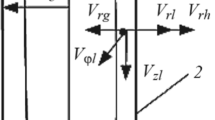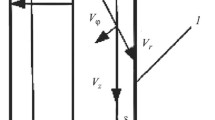The mathematical model of separation of inhomogeneous fluid systems in centrifugal force field is adapted to viscoplastic fluid purification in a cylindroconical hydrocyclone by pressure flotation process. The model takes account of the action of inertial and Coriolis forces and associated mass of fluid. The system of partial differential equations describing the flotation process is reduced to a system of ordinary differential equations and solved numerically taking account of the geometry of the working space of the cylindroconical hydrocyclone. Based on the developed mathematical model, the influence of the separation factor on the residual concentration of the solid phase particles at different values of the cone angle of the body and the plasticity number was analyzed. Physical justification of the results is enunciated. The obtained results can be used to design equipment for viscoplastic fluid separation in hydrocyclone by pressure flotation.



Similar content being viewed by others
References
A. A. Abramov, Flotation Methods of Enrichment [in Russian], Vol. 4, MGTU, Moscow (2008).
M. G. Lagutkin and A. P. Klimov, “Behavior of gas bubbles in a hydrocyclone,” Teor. Osn. Khim. Tekhnol., 27, No. 5, 468-472 (1993).
M. M. Basharov and O. A. Sergeeva, Device and Calculation of Hydrocylones: A Textbook [in Russian], edited by A. G. Laptev, Vestfalika, Kazan (2012).
V. A. Dikov and D. E. Sukhanov, “Study of the possibility of hydrocyclone use for centrifugal-flotation enrichment of potassium-containing ores,” Inzhenern. Vestn. Dona, 2, No. 4 (27), 23–26 (2013).
O. R. Karataev and Z. R. Shamsutdinov, “Modeling of separation processes in flotation hydrocyclones,” Vestn. Tekhnol. Univ., 18, No. 16, 117-119 (2015).
A. M. Kutepov, M. G. Lagutkin, G. V. Pavlovsky, and V. I. Mushtaev, “Separation of disperse systems in hydrocyclones with additional injection of dispersed gas,” Teor. Osn. Khim. Tekhnol., 33, No. 5, 571-577 (1999).
V. O. Yablonskiy and G. V. Rabchuk, “Flow of rheologically complex suspension in cylindroconical hydrocyclone,” Teor. Osn. Khim. Tekhnol., 39, No. 4, 355-361 (2005).
C. Acary-Robert, E. D. Fernández-Nieto, G. Narbona-Reina, and P. Vigneaux, “Viscoplastic free-surface flows: the Herschel–Bulkley case,” Seventh International Conference on Computational Fluid Dynamics (ICCFD7), Big Island, Hawaii, July 9-13 (2012), pp. 1-15.
T. Dyakowski, G. Hornung, and R. A. Williams, “Simulation of non-Newtonian flow in a hydrocyclone,” Chem. Eng. Res. Des. A, 72, No. 4, 520-523 (1994).
B. V. Deryagin, S. S. Dukhin, and N. N. Rulev, Microflotation: Water Purification, Enrichment [in Russian], Khimiya, Moscow (1986).
N. V. Tyabin, G. L. Dakhina, A. B. Golovanchikov, and A. A. Mamakov, “Calculation of ideal-displacement apparatuses for separation of fine suspensions by electrolysis gases,” Teor. Osn. Khim. Tekhnol., 13, No. 6, 880-884 (1979).
V. O. Yablonskiy, “Modeling of the influence of design parameters of cylindrical hydrocyclone on indicators of viscoplastic fluid cleaning by flotation method,” Khim. Neftegaz. Mashinostr., No. 10, 15-18 (2022).
Author information
Authors and Affiliations
Corresponding author
Additional information
Translated from Khimicheskoe i Neftegazovoe Mashinostroenie, Vol. 59, No. 3, pp. 6–9, March, 2023.
Rights and permissions
Springer Nature or its licensor (e.g. a society or other partner) holds exclusive rights to this article under a publishing agreement with the author(s) or other rightsholder(s); author self-archiving of the accepted manuscript version of this article is solely governed by the terms of such publishing agreement and applicable law.
About this article
Cite this article
Yablonskiy, V.O. Modeling of Viscoplastic Fluids Separation in a Cylindroconical Hydrocyclone by Pressure Flotation. Chem Petrol Eng 59, 191–197 (2023). https://doi.org/10.1007/s10556-023-01227-z
Published:
Issue Date:
DOI: https://doi.org/10.1007/s10556-023-01227-z




